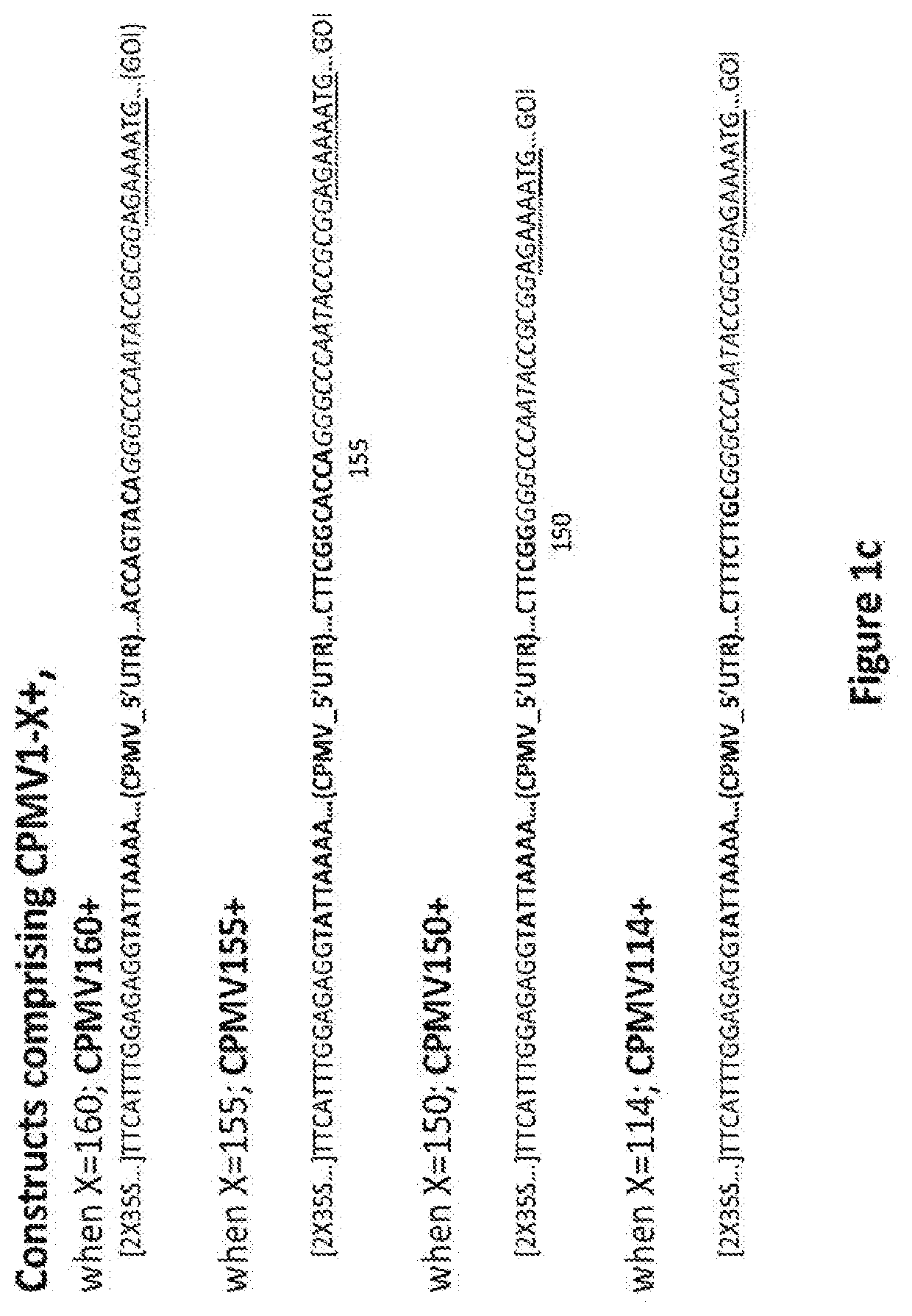CPMV Enhancer Elements
a technology of enhancer elements and proteins, applied in the field of plants' expression of proteins of interest, can solve the problems of limiting the size of inserted sequences, time-consuming and labor-intensive processes, etc., and achieves the effects of efficient local or systemic infection of inoculated plants, good yield of useful protein materials, and easy infecting plants
- Summary
- Abstract
- Description
- Claims
- Application Information
AI Technical Summary
Benefits of technology
Problems solved by technology
Method used
Image
Examples
example 1
V-HT / PDISP / H3 Victoria / NOS (Construct Number 1391)
[0166]A sequence encoding H3 from Influenza A / Victoria / 361 / 2011 in which the native signal peptide has been replaced by that of alfalfa protein disulfide isomerase (PDISP / H3 Victoria) was cloned into 2X35S-CPMV-HT-NOS expression system (original CMPV-HT) using the following PCR-based method. A fragment containing the PDISP / H3 Victoria coding sequence was amplified using primers IF-PDI.S1+3c (FIG. 6A, SEQ ID NO: 67) and IF-H3V36111.s1-4r (FIG. 6B, SEQ ID NO: 17), using PDISP / H3 Victoria sequence (FIG. 6C, SEQ ID NO:18) as template. The PCR product was cloned in 2X35S / CPMV-HT / NOS expression system using In-Fusion cloning system (Clontech, Mountain View, Calif.). Construct number 1191 (FIG. 6D) was digested with SacII and StuI restriction enzyme and the linearized plasmid was used for the In-Fusion assembly reaction. Construct number 1191 is an acceptor plasmid intended for “In Fusion” cloning of genes of interest in a CPMV-HT-based exp...
example 2
V160+ / PDISP / H3 Victoria / NOS (Construct Number 1800)
[0167]A sequence encoding H3 from Influenza A / Victoria / 361 / 2011 in which the native signal peptide has been replaced by that of alfalfa protein disulfide isomerase (PDISP / H3 Victoria) was cloned into 2X35S / CPMV160+ / NOS expression system (CPMV160+) using the following PCR-based method. A fragment containing the PDISP / H3 Victoria coding sequence was amplified using primers IF**(SacII)-PDI.s1+4c (FIG. 7A, SEQ ID NO: 22) and IF-H3V36111.s1-4r (FIG. 7B, SEQ ID NO: 23), using PDISP / H3 Victoria sequence (FIG. 7C, SEQ ID NO: 24) as template. The PCR product was cloned in 2X35S / CPMV160+ / NOS expression system using In-Fusion cloning system (Clontech, Mountain View, Calif.). Construct number 2171 (FIG. 7D) was digested with SacII and StuI restriction enzyme and the linearized plasmid was used for the In-Fusion assembly reaction. Construct number 2171 is an acceptor plasmid intended for “In Fusion” cloning of genes of interest in a CPMV160+ bas...
example 3
V160 / PDISP / H3 Victoria / NOS (Construct Number 1935)
[0168]A sequence encoding H3 from Influenza A / Victoria / 361 / 2011 in which the native signal peptide has been replaced by that of alfalfa protein disulfide isomerase (PDISP / H3 Victoria) was cloned into 2X35S-CPMV160-NOS expression using the following PCR-based method. A fragment containing the PDISP / H3 Victoria coding sequence was amplified using primers IF-CPMV(fl5′UTR)_SpPDI.c (FIG. 8A, SEQ ID NO: 28) and IF-H3V36111.s1-4r (FIG. 7B, SEQ ID NO: 23), using PDISP / H3 Victoria sequence (FIG. 7C, SEQ ID NO: 24) as template. The PCR product was cloned in 2X35S / CPMV160 / NOS expression system using In-Fusion cloning system (Clontech, Mountain View, Calif.). Construct number 1190 (FIG. 8B) was digested with SacII and StuI restriction enzyme and the linearized plasmid was used for the In-Fusion assembly reaction. Construct number 1190 is an acceptor plasmid intended for “In Fusion” cloning of genes of interest in a CPMV160-based expression casse...
PUM
| Property | Measurement | Unit |
|---|---|---|
| pH | aaaaa | aaaaa |
| pH | aaaaa | aaaaa |
| pH | aaaaa | aaaaa |
Abstract
Description
Claims
Application Information
 Login to View More
Login to View More - R&D
- Intellectual Property
- Life Sciences
- Materials
- Tech Scout
- Unparalleled Data Quality
- Higher Quality Content
- 60% Fewer Hallucinations
Browse by: Latest US Patents, China's latest patents, Technical Efficacy Thesaurus, Application Domain, Technology Topic, Popular Technical Reports.
© 2025 PatSnap. All rights reserved.Legal|Privacy policy|Modern Slavery Act Transparency Statement|Sitemap|About US| Contact US: help@patsnap.com



